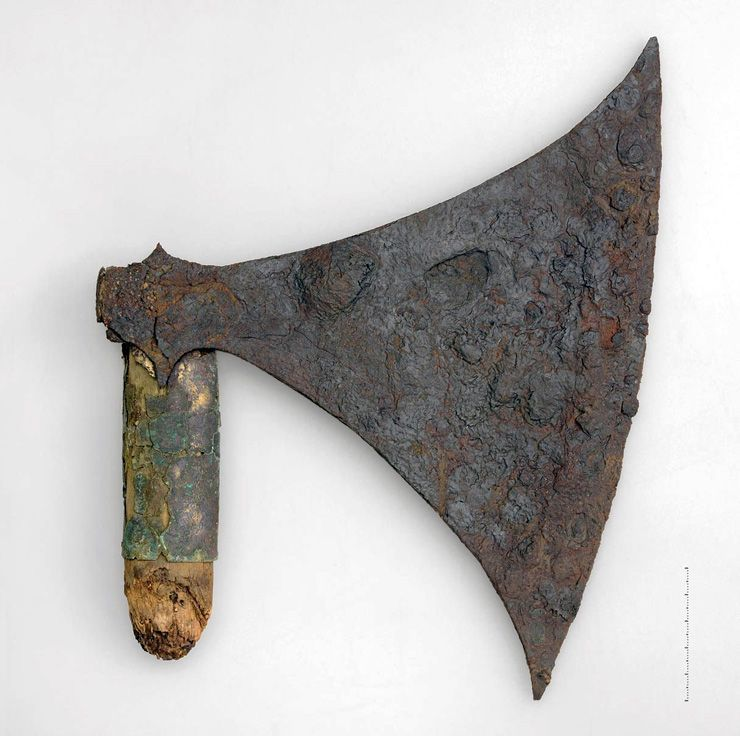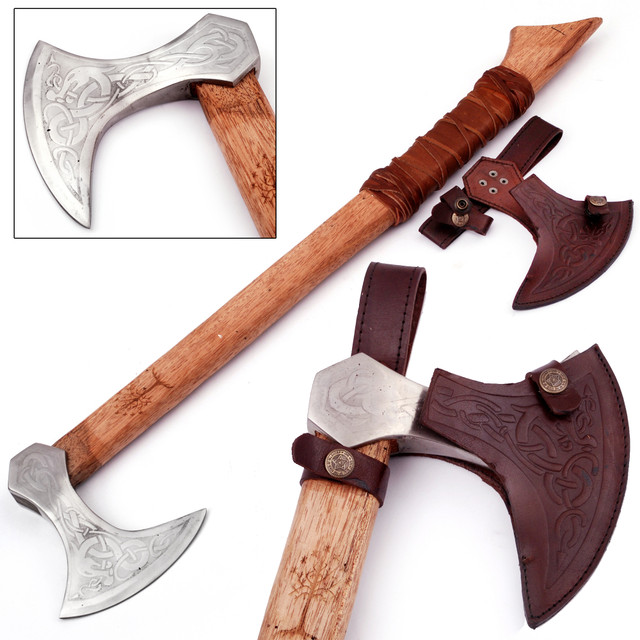3 Hidden Meanings Behind the Medieval Battle Axe
Posted by Swordsswords on Feb 27th 2024
We have all seen the movies: a Viking warrior gripping a mighty battle axe , its sharp edge glinting in the sun. These iconic weapons are synonymous with medieval warfare, their power and ferocity etched in our minds. But did you know, underneath their imposing exterior, battle axe held hidden meanings that transcended the battlefield? From symbol of strength to everyday tool, the battle axe played a fascinating role in medieval society, revealing a depth and cultural significance often overlooked. So, join us as we delve into 3 surprising ways the battle axe went beyond its fearsome reputation, becoming much more than just a weapon of war. Prepare to see the medieval battle axe in a whole new light!

Evolution of the Battle Axe:
While exploring the battle axe's hidden meanings, it's important to acknowledge its evolution throughout the medieval period. This journey reflects not only changing warfare tactics but also the ingenuity of weapon-smiths.
Early Medieval Axes (5th-10th Centuries):
During this period, battle axes were primarily functional tools adapted for combat. Designs were simpler, often featuring a single-headed viking axe head mounted on a sturdy wooden haft. Examples include the Frankish francisca , a throwing viking axe known for its lethality, and the Viking bearded axe , characterized by its wider blade with pronounced "horns" at the base.
High Medieval Axes (11th-13th Centuries):
As warfare evolved, so did the battle axe. The High Medieval period witnessed increased complexity and variety in hand forged axes design. Longer hafts and lighter heads became more common, offering greater reach and maneuverability. This era also saw the emergence of the Dane axe , a formidable weapon with a long, slender blade favored by Vikings and other North European warriors.
Late Medieval Axes (14th-15th Centuries):
The Late Medieval period witnessed a specialization of battle axes for different combat styles and purposes. Heavier axes with blunter edges were designed to crush armor, while two handed axes with longer handles offered immense power for breaking enemy formations. Additionally, pollaxes emerged, combining an axe head with a hammer head and a spike, providing versatility in different combat situations
Hidden Meaning #1: Symbol of Strength and Power
The mere sight of a battle axe evokes the image of a powerful warrior, its hefty weight and sharp edge whispering tales of dominance on the battlefield. This association with physical prowess wasn't just a perception; it was a deeply ingrained cultural understanding.
Vikings, known for their fearsome raids and exploration, were synonymous with the double headed axe , a weapon designed to cleave through both armor and bone. Their impressive stature and skilled axe-wielding fueled the image of the battle ready axe as a symbol of unmatched strength. Similarly, Germanic warriors revered the francisca, a throwing battle ax known for its deadly accuracy and the warrior's skill in wielding it.
Beyond real-world examples, the battle axe found its way into mythology and literature. Thor, the Norse god of thunder, wielded the mighty Mjolnir , a hammer-like axe representing his immense power and ability to protect. In the epic poem Beowulf, the titular hero slays the monstrous Grendel with a giant's axe, highlighting the weapon's association with heroism and victory.
Even in art, the battle axe served as a visual representation of strength and power. Depictions of warriors wielding axes adorned tapestries, sculptures, and paintings, further solidifying the weapon's symbolic significance.
Therefore, the medieval battle axe transcended its physical form to become a powerful symbol. It represented the ideal warrior, a figure of immense strength, courage, and dominance, leaving an enduring mark on medieval culture.
Hidden Meaning #2: Tool for Everyday Life
While often associated with warfare and violence, the battle axe surprisingly held a hidden meaning as a versatile tool for everyday life. It wasn't just a weapon wielded by warriors, but an essential companion for many ordinary people.
The versatility of the battle axe lay in its sturdy design. Its heavy head and sharpened edge made it perfect for chopping wood, a crucial task for building homes, furniture, and keeping fires warm. Carpenters and construction workers utilized the axe for framing timbers and splitting planks. Even in agriculture, it played a role in clearing land, chopping down trees, and preparing fields for planting.
Owning and using an axe also held a social significance. In a predominantly rural society, the ability to handle an axe effectively denoted competence and resourcefulness. It was a sign of an individual's contribution to the community, whether it be a farmer clearing land, a woodcutter providing fuel, or a craftsman building essential structures. In some cases, the quality and ornamentation of the axe could even reflect a person's social standing. A well-crafted and decorated axe might belong to a skilled craftsman or a landowner, hinting at their higher social status.
Hidden Meaning #3: A Status Symbol and Marker of Identity
While the medieval axe served a practical purpose and symbolized strength, it also held a hidden meaning as a status symbol and marker of identity in medieval society. This meaning was intricately woven into the decorative elements found on some battle axes, revealing layers of social and cultural significance.
High-quality battle axes, often owned by nobility or elite warriors, were adorned with elaborate decorations that showcased the owner's wealth and social standing. These embellishments could include:
- Inlaid precious metals: Gold, silver, or even jewels were incorporated into the axe head or along the shaft, demonstrating the owner's affluence and social prestige.
- Engraved designs: Complex patterns, heraldic symbols, or even religious imagery were etched onto the axe, signifying the owner's lineage, allegiance, or religious beliefs.
- Intricate metalwork: The axe head itself could be crafted from high-quality steel, intricately shaped and polished, highlighting the skill of the blacksmith and the owner's ability to afford such craftsmanship.

Beyond individual status, the design of the battle axe could also reveal cultural identity. Certain regional variations existed, with specific shapes, materials, and ornamentation unique to different cultures. For example, the Danish axe with its long, slender blade and pronounced "horns" distinguished itself from the broader head and shorter haft of the Frankish francisca. This visual distinction served as a subtle marker of the owner's cultural background and potentially their clan or social group within that culture.
Intrigued by the stories of these historical weapons? Check out our blog on all types of medieval axes for sale . Buy yourself a medieval battle axe today from swordsswords.com!

